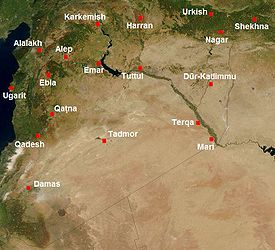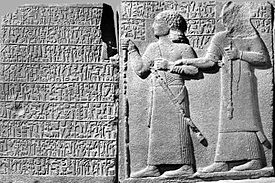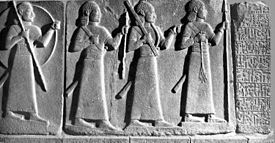- Carchemish
-
Coordinates: 36°49′47″N 38°00′54″E / 36.82972°N 38.015°E
Carchemish or Kargamış (Hittite: Kargamiš;[1] Greek: Εὔρωπος; Latin: Europus) was an important ancient city of the Mitanni, Hittite and Neo Assyrian Empires, now on the frontier between Turkey and Syria. It was the location of an important battle between the Babylonians and Egyptians, mentioned in the Bible. The city is known locally as Jerablus (also Djerablus, Jerabulus, Jarablos, Jarâblos) [6], linking it to the Biblical city of Jerablus; a corrupted form of the name is Djerabis. The town of Jarablus lies by the Outer Town on the Syrian side of the border, and the Turkish side hosts the town of Karkamis. Modern urban and agricultural expansions and a minefield, (cleared in 2010 [2]), have threatened the archaeological integrity of the site. Global Heritage Fund is working with Durham University's Land of Carchemish Project [7] to map the damage to the site.
Contents
History
The site has been occupied since the Neolithic period, with pottery finds from ca. 3000 BC and tombs from ca. 2300 BC (Early Bronze Age). The city is mentioned in documents found in the Ebla archives of the 3rd millennium BC. According to documents from the archives of Mari and Alalakh, dated from ca. 1800 BC, Carchemish was then ruled by a king named Aplahanda and was an important center of timber trade. It had treaty relationships with Ugarit and Mitanni (Hanilgalbat). In ancient times, the city commanded the main ford in the region across the Euphrates, a situation which must have contributed greatly to its historical and strategic importance.
Pharaoh Thutmose I of the Eighteenth Dynasty erected a stela near Carchemish to celebrate his conquest of Syria and other lands beyond the Euphrates. Around the end of the reign of Pharaoh Akhenaten, Carchemish was captured by king Suppiluliuma I of the Hittites (ca. 14th century BC), who made it into a kingdom ruled by his son Piyashshili.
The city became one of the most important centres in the Hittite Empire, during the Late Bronze Age, and reached its apogee around the 11th century BC. While the Hittite empire fell to the Sea Peoples during the Bronze Age collapse, Carchemish survived the Sea People's attacks to continue to be the capital of an important "Neo-Hittite" kingdom in the Iron Age, and a trading center. Although Ramesses III states in an inscription dating to his 8th Year from his Medinet Habu mortuary temple that Carchemish was destroyed by the Sea Peoples, the city evidently survived the onslaught of the Sea Peoples.[3] King Kuzi-Tesup I is attested in power here and was the son of Talmi-Teshub who was a contemporary of the last surviving Hittite king, Suppiluliuma II.[4] He and his successors ruled a small empire stretching from Southeast Asia Minor to Northern Syria and the West Bend of the Euphrates.[5] under the title of 'Great Kings.' This suggests that Kuzi-Tesub saw himself as the true heir of the line of the great Suppiliuma I and that the central dynasty at Hattusa was now defunct.[6] This Empire lasted from c.1175 to 990 BC when it lost control of its imperial possessions and became a mere local city state centered around Carchemish.[7]
The patron of Carchemish under the Hittites was Kubaba, a goddess of apparently Hurrian origins. She was represented as a dignified woman wearing a long robe, standing or seated, and holding a mirror.
In the 9th century BC, the city paid tribute to Kings Ashurnasirpal II and Shalmaneser III of Assyria, and was conquered by Sargon II in 717 BC, in the reign of King Pisiris.
In the summer of 605 BC, the Battle of Carchemish was fought there by the Babylonian army of Nebuchadrezzar II and that of Pharaoh Necho II of Egypt and the remnants of the Assyrian army. (Jer. 46:2). The aim of Necho's campaign was to contain the Westward advance of the Babylonian Empire and cut off its trade route across the Euphrates. However, the Egyptians were defeated by the unexpected attack of the Babylonians and were eventually expelled from Syria.
Archaeology
Carchemish is now an extensive set of ruins, located on the West bank of Euphrates River, about 60 kilometres (37 mi) southeast of Gaziantep, Turkey and 100 kilometres (62 mi) northeast of Aleppo, Syria. The site lies in Turkish territory near the frontier between the two countries. A Turkish military base has been built on the Carchemish acropolis and Inner Town, and access to that part of the site is presently restricted. Most of the Outer Town lies in Syrian territory.
Carchemish has always been well known to scholars because of several references to it in the Bible (Jer. 46:2; 2 Chr. 35:20; Isa. 10:9) and in Egyptian and Assyrian texts. However, its location was identified only in 1876 by George Smith. The city had been previously identified, incorrectly, with Circesium at the confluence of the Chebar and the Euphrates.[8] It has also been identified with the Hierapolis Bambyce of the Greek, although the modern Pamukkale in Turkey also had that name.
The site was excavated by the British Museum, in 1876 by George Smith, 1881 by Patrick Henderson, 1911 by D. G. Hogarth and R. C. Thompson, and from 1912 to 1914 and again in 1920 by C. L. Woolley, and T. E. Lawrence ("Lawrence of Arabia").[9][10][11][12] Excavations were interrupted in 1914 by World War I and then ended with the Turkish War of Independence.[13] These expeditions uncovered substantial remains of the Assyrian and Neo-Hittite periods, including defensive structures, temples, palaces, and numerous basalt statues and reliefs with Luwian hieroglyphic inscriptions.
Though the previously excavated areas in the Inner Town in Turkey have been off limits to archaeology, work in the Outer Town and surrounding region has added more insight to Carchemish.[14] With the completion of mine clearing operations on the Turkish portion of the site, archaeological work is expected to proceed there shortly. [15] Excavations in the Inner Town are planned by a joint team from the Turkish Universities of Gaziantep and Istanbul and Bologna University (Italy). The team from the University of Bologna is led by Prof. Nicolo Marchetti. [16]
Archaeological investigations on the Syrian side have been conducted as part of The Land of Carchemish Project [8], an ongoing project which started in 2006, under the direction of Professor T.J. Wilkinson (Durham University) [9] and Professor E. Peltenburg (University of Edinburgh) [10], and building upon the Jerablus Tahtani Project [11] directed by Professor Peltenburg. The work is part of the Fragile Crescent Project at Durham University [12], which aims to advance understanding of the settlement landscapes of Upper Mesopotamia and the northern Levant. Investigations of the Outer Town of Carchemish are continuing in conjunction with the DGAM in Damascus.
The Land of Carchemish Project has benefitted from the funding and sponsorship of the Council for British Research in the Levant, and is continuing with funding from the British Academy, and for the 2010 season from the Global Heritage Fund. It was designed with the aim of redressing the imbalance in archaeological survey work which has resulted from the large number of rescue excavations instigated as a result of the creation of dams on the Euphrates. The Project aimed to provide a broader landscape context to Carchemish, investigating the terrain away from the river. It has demonstrated that the area was well settled throughout the Holocene period and that the seemingly dense settlement of the Euphrates Valley continues away from the river valley towards the west. Consequently, the ‘abundant pasture lands’ posited as a requirement of the models of tribal states need to be fitted within a landscape of settlement, and presumably control, by a number of local communities. Although there is some attenuation into the uplands, the presence of dense settlement in relatively minor valleys such as the Nahr al Amarna as well as on the upland plains to the west, provides a counterweight to the better known spreads of settlement along the Euphrates.
Some 40% of the Outer Town of Carchemish remains within Syria. The site of Carchemish, and particularly the Outer Town area, has been designated an endangered cultural heritage site and labelled “at risk” by the Global Heritage Fund, a non-profit organisation, due to the minefield, urban encroachment, and agricultural expansion. In the 2010 field season the Land of Carchemish Project team undertook an assessment of the Syrian part of the Outer Town in order to try to safeguard it from urban encroachment. Unfortunately, not only have parts of the modern border town of Jerablus encroached upon the Outer Town, but also since around 2000, a number of houses have been constructed within the agricultural area between the border (now demarcated by the Baghdad Railway) and the modern town. Consequently a critical component of the work of the team involved defining limits of the ancient city in relation to the modern town [17].
Kings of Carchemish
Ruler Proposed reign Notes Piyassilis or Sharri-Kushukh ca. 1315 son of the Hittite king Suppiluliuma I [...]sharruma son of Piyassilis Sharkhurunuwa son of Piyassilis Ini-Teshub I ca. 1230s Talmi-Teshub ca. 1200 Kuzi-Teshub ca. 1170 claimed the title of "Great King" after the fall of Hatti Ini-Teshub II ca. 1100 Tudhaliya ca. 1100 either before or after Ini-Teshub II [...]pazitis Ura-Tarhunzas Suhis I Astuwatamanzas Suhis II Katuwas ca. 900 Sangara 870-848 Astiruwas ca. 840 Yariris or Araras ca. 815 Kamanis ca. 790 Sasturas ca. 760 Pisiris ca. 730s the last king, defeated in 717 by Sargon II Notes
- ^ "Kargamiš." Reallexikon der Assyriologie und Vorderasiatischen Archäologie. Walter de Gruyter (1980).
- ^ [1]) Ancient city to rise in SE Turkey area cleared of mines. Daily News and Economic Review 31.03.2011
- ^ Gary Beckman, "Hittite Chronology", Akkadica, pp.119–120 (2000), p.23
- ^ K.A. Kitchen, On the Reliability of the Old Testament, William B. Eerdsman Publishing Co, pp.99 & 140
- ^ Kitchen, op. cit., p.99
- ^ Trevor R. Bryce, The Kingdom of the Hittites, Oxford University Press, p.384
- ^ Kitchen, op. cit., p.100
- ^ CATHOLIC ENCYCLOPEDIA: Circesium
- ^ [2] David George Hogarth, Hittite problems and the excavation of Carchemish, H. Frowde, 1911 (Nabu Press, 2010, ISBN 9781171636991)
- ^ D.G. Hogarth, Carchemish I: Introductory, The British Museum Press, 1969
- ^ Sir L.Woolley, Carchemish: Town Defences Pt. 2: Report on the Excavations at Jerablus on Behalf of the British Museum, British Museum Press, 1969, ISBN 0714110027
- ^ Sir L.Woolley & R.D.Burnett, Carchemish: Excavations in the Inner Town Pt.3: Report on the Excavations at Jerablus on Behalf of the British Museum, British Museum Press, 1978, ISBN 0714110035
- ^ H. G. Güterbock, Carchemish, Journal of Near Eastern Studies, vol. 13, no. 2, pp. 102-114 , 1954
- ^ Edgar Peltenburg, Euphrates River Valley Settlement: The Carchemish Sector in the Third Millennium BC, Oxbow Books, 2007, ISBN 1-84217-272-7
- ^ [3] Ancient city to rise in SE Turkey area cleared of mines. Daily News & Economic Review 31.03.2011
- ^ [4] Dünya arkeoloji tarihinin kaderi Karkamış’la değişecek. Denge 02.05.2011
- ^ [5] T.J. Wilkinson and E. Peltenberg. 2010. Carchemish in Context: Surveys in the Hinterland of a Major Iron Age City. Bulletin of the Council for British Research in the Levant, Volume 5, Number 1, November 2010 , pp. 11-20(10)
See also
References
- David Ussishkin, Observations on Some Monuments from Carchemish, Journal of Near Eastern Studies, vol. 26, no. 2, pp. 87–92, 1967
- C. W. Ceram, The Secret of the Hittites: The Discovery of an Ancient Empire. Phoenix Press (2001), ISBN 1-84212-295-9.
- J. D. Hawkins, Corpus of Hieroglyphic Luwian Inscriptions I/1. de Gruyter, Berlin 2000, ISBN 978-3-11-010864-4.
- David M. Wilson, The British Museum, a history. The British Museum Press, London, 2002.
External links
Categories:- Carchemish
- Syro-Hittite states
- Archaeological sites in Syria
- Archaeological sites in Turkey
- Former populated places in Syria
- Roman towns and cities in Syria
- Gaziantep Province
Wikimedia Foundation. 2010.




